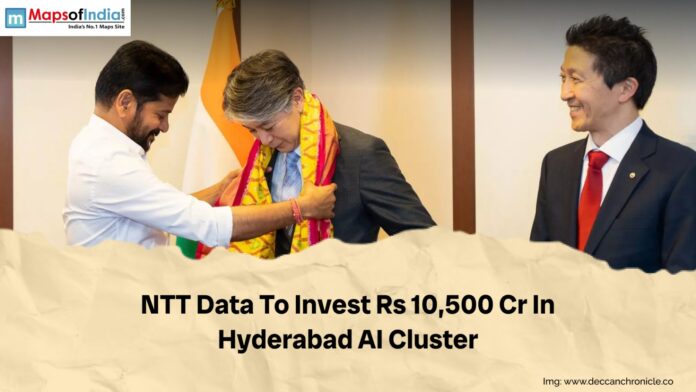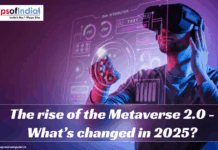Leading global provider of IT services and data centres NTT Data has announced an investment of ₹10,500 crore to build the biggest AI data centre cluster in Hyderabad, in a historic step meant to redefine India’s digital and artificial intelligence (AI) scene. Under the direction of Neysa Networks and the Government of Telangana, this ambitious project is set to establish Hyderabad as the epicentre of AI innovation and supercomputing in India, fostering economic growth, technological advancement, and talent development all around.
Investment: Vision and Scale
Attached by Telangana Chief Minister A. Revanth Reddy, senior executives from NTT Data and Neysa Networks, Japanese investors, and the tripartite Memorandum of Understanding (MoU) were formalised during a high-level investment conference in Tokyo. Comprising 25,000 cutting-edge Graphics Processing Units (GPUs), the project’s 400 MW data centre cluster is meant to manage public and business AI loads. Supporting the development and implementation of advanced AI solutions at scale, this facility will be the most powerful artificial intelligence supercomputer in India.
“This landmark investment reflects Telangana’s rise as India’s leading data centre hub,” Chief Minister Revanth Reddy said, stressing the strategic relevance of this investment. We provide policy stability, trained expertise, consistent power, and fastest single-window clearances. Hyderabad is ready to lead the next wave of digital services and artificial intelligence.
Capacity for Technology and Infrastructure
-
400 MW Data Centre Cluster
Unprecedented in India, the 400 MW capacity of the Hyderabad facility ranks among the biggest data centre campuses in Asia with an eye towards artificial intelligence. The cluster’s 25,000 GPUs will offer the computational horsepower required for training and deploying generative artificial intelligence, machine learning algorithms, other data-intensive applications, and big language models.
-
Sustainable and Green Operations
The project stands out mostly for its dedication to sustainability. With a total capacity of up to 500 MW, the data centre will be run on a mix of grid and renewable energy sources. This method guarantees dependable and scalable energy for high-performance computing and meets worldwide Environmental, Social, and Governance (ESG) criteria. Liquid immersion cooling is one of the advanced technologies used to maximise energy economy and reduce the facility’s carbon footprint.
-
Modern Cooling and Security
Using liquid immersion cooling, a novel approach that greatly increases energy efficiency over conventional air cooling, the centre will be able to control the enormous heat produced by thousands of GPUs. The facility will also follow strict security rules and data sovereignty requirements, which will suit delicate public sector and business operations.
Strategic Partnerships: Neysa Networks and NTT Data
-
NTT Data: International Knowledge
With its headquarters in Tokyo, NTT Data operates more than 150 data centres worldwide and employs almost 193,500 people in more than 50 countries. The company is ranked among the top three data centre suppliers worldwide and serves 75% of the Fortune Global 100. Already running or building eighteen data centres across major Indian cities, NTT Data has over 265 MW of capacity.
-
AI-first Cloud Platform: Neysa Networks
Mumbai-based Neysa Networks is an artificial intelligence-first cloud platform company that aims to democratise access to cutting-edge technology. The firm offers GPU cloud solutions with access to top-notch Nvidia L40 and H100 GPUs. Working with NTT Data, Neysa will hasten the creation of sovereign and scalable AI solutions catered to Indian businesses and public sector needs.
-
Telangana’s Vision: Rising as India’s AI Capital
A pillar of Telangana’s larger plan to become the “AI capital of India,” the NTT Data investment provides policy stability, dependable infrastructure, trained talent, and simplified regulatory processes. The state government has aggressively created an enabling ecosystem for digital innovation. Already drawing major investments from international companies, including AWS, STT GDC, CtrlS, Tillman Global Holdings, Microsoft, and Google, Hyderabad’s ranking as India’s fastest-growing data centre hub is further reinforced.
Driven by exploding demand for cloud computing, artificial intelligence, and big data analytics, the Hyderabad data centre market is expected to triple capacity by 2031 as per reports. The new NTT Data–Neysa facility will be a major engine of this development, supporting not only local businesses but also national digital transformation projects.
Social and Economic Influence
-
Talent Development and Employment Creation
The AI data centre cluster is expected to create hundreds of direct and indirect jobs across building, operations, IT, engineering, and support services. More importantly, NTT Data and Neysa Networks will work with academic institutions in Telangana to develop AI talent by providing training, research possibilities, and industry partnerships to create a strong talent pool.
-
Start-up Ecosystems and Innovation
The facility will allow Indian start-ups, research labs, and businesses to access world-class AI resources by offering sovereign, scalable, and sustainable compute infrastructure. This democratisation of high-performance computing is likely to spur creativity in fields including smart cities, manufacturing, finance, agriculture, and healthcare.
-
Building India’s Digital Public Infrastructure
The initiative fits India’s goal of creating scalable, accessible, and secure digital public infrastructure. The AI cluster will assist in e-governance, citizen services, and digital inclusion projects, bridging the digital divide and empowering communities in Telangana and beyond.
-
Environmental and Social Governance (ESG) pledges
NTT Data’s Hyderabad campus will follow the highest ESG criteria, incorporating renewable energy, energy-efficient cooling, and responsible resource management. The company’s emphasis on sustainability reflects not only its response to legal obligations but also its dedication to long-term value creation for society and stakeholders.
Competitive Landscape: Hyderabad, a Data Centre Powerhouse
Major operators, including CtrlS, Nxtra, Microsoft, Amazon, STT GDC, Pi, CapitaLand, and WebWerks/Iron Mountain, highlight Hyderabad’s ascent as a data centre powerhouse. The city’s strategic location, strong infrastructure, and progressive policies have made it the preferred place for worldwide technology investments.
The NTT Data–Neysa project will strengthen Hyderabad’s position as a regional and worldwide hub for digital innovation by attracting more investments and augmenting its competitive edge.
Government Support and Global Cooperation
During the Chief Minister’s recent trip to Japan, where he personally presented the state’s benefits to over 150 top Japanese investors, the Telangana government’s proactive approach to attracting investment was clear-cut. Large-scale projects like the NTT Data AI cluster have been largely secured by the government’s single-window clearance system, policy consistency, and commitment to infrastructure development.
Indeed, the cooperation between Japanese and Indian companies is growing to reflect the broader trend of international technological partnership, which is now emerging around the world. This partnership utilises the complementing strengths between the two nations and encourages cross-border innovation.
Future Challenges and Prospects
Scaling AI Infrastructure
The demand for high-performance computing infrastructure will explode as artificial intelligence acceptance quickens in many sectors. Future Indian investments will be modelled on the NTT Data AI cluster, which shows the viability and advantages of massive, environmentally friendly, safe data centre operations.
Promoting Regulatory Gaps and Talent
Although the initiative offers great advantages, developing enough AI talent, guaranteeing data privacy and security, and negotiating changing legal environments still present difficulties. To address these issues and maintain long-term development, industry, government, and academia must constantly collaborate.




